Navigation
On April 2, 2025, Sulabh International inaugurated the Dr. Bindeshwar Pathak Memorial Centre on his 82nd birth anniversary. The Memorial chronicles the life and work of Dr. Pathak, who led a nationwide sanitation movement to persuade millions of India to adopt an affordable toilet system that he developed in 1968.
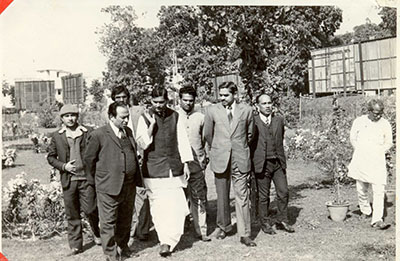 Dr. Pathak
Dr. Pathak
Our session will explore “Seeing the unseen: The value of water,” including climate change, ecosystems, sociocultural and economic factors along with how water scarcity, poor water quality and inadequate sanitation negatively impact food security, livelihood choices and educational opportunities for poor families across the world and, in fact, everyone.
 Horizon International logo and book cover design created by Bela Selendy
Horizon International logo and book cover design created by Bela Selendy
13 March 2022 -- Geneva / New York -- “Today, we call for an immediate cessation of all attacks on health care in Ukraine. These horrific attacks are killing and causing serious injuries to patients and health workers, destroying vital health infrastructure and forcing thousands to forgo accessing health services despite catastrophic needs.
"To attack the most vulnerable – babies, children, pregnant women, and those already suffering from illness and disease, and health workers risking their own lives to save lives – is an act of unconscionable cruelty.

JOINT STATEMENT
Two successful MAP projects ...are Nai Nang Village in Thailand, and the Bay of Jiquilisco in El Salvador. In both, after the initial Community-based Ecological Mangrove Restoration (CBEMR) training and restoration, the projects and conservation have been locally driven and shaped as a result of working together.
Jennifer Selendy worked with seven people, including Royesh, to rescue more than 500 people, including more than 400 schoolgirls, their family members and teachers, from October through November, according to the Thirty Birds Foundation, at https://www.30birdsfoundation.org/, the organization their group founded to support the evacuation mission.
“I could not live with myself if I did not act to help women and girls facing such extreme emotional and physical abuse and systemic injustice,” Jennifer Selendy, Managing partner Selendy & Gay.
 Selendy & Gay co-managing partner Jennifer Selendy (fourth from left) with the Behroozian family,: after safely landing in Saskatoon, Canada. Courtesy photo.
Selendy & Gay co-managing partner Jennifer Selendy (fourth from left) with the Behroozian family,: after safely landing in Saskatoon, Canada. Courtesy photo.
“I could not live with myself if I did not act to help women and girls facing such extreme emotional and physical abuse and systemic injustice,” Jennifer Selendy, Managing partner Selendy & Gay.
On April 1, 2021, the UN Food Systems Summit announced that more than 1,200 ideas and propositions to transform food systems were presented in just six months of public engagement.
Since September, the Summit has hosted regular online meetings, public fora and surveys organised around five priority objectives for more equitable and sustainable food systems.
UN Food Systems Summit opened the floor to governments, farmers, youth, women and indigenous groups, scientists and civil society to uncover innovations to transform food systems.
On April 1, 2021, the UN Food Systems Summit announced that more than 1,200 ideas and propositions to transform food systems were presented in just six months of public engagement.
“Today is a great day for science and humanity. The first set of results from our Phase 3 COVID-19 vaccine trial provides the initial evidence of our vaccine’s ability to prevent COVID-19,” said Dr. Albert Bourla, Pfizer Chairman and CEO. “We are reaching this critical milestone in our vaccine development program at a time when the world needs it most with infection rates setting new records, hospitals nearing over-capacity and economies struggling to reopen."
[img_assist|nid=1624|title=COVID-19 is the infectious disease caused by the coronavirus, SARS-CoV-2, which is a respiratory pathogen.|desc=WHO first learned of this new virus from cases in Wuhan, People’s Republic of China on 31 December 2019. This is a colorized scanning electron micrograph of an apoptotic cell (red) heavily infected with SARS-COV-2 virus particles (yellow), isolated from a patient sample. Image captured at the NIAID Integrated Research Facility (IRF) in Fort Detrick, Maryland.
China has made progress in improving water supply and sanitation(WSS) coverage over recent decades. The WSS services include water treatment plants and pipelines, sewer networks and wastewater treatment plants, and household service connections.
We take Zhejiang province as an example.
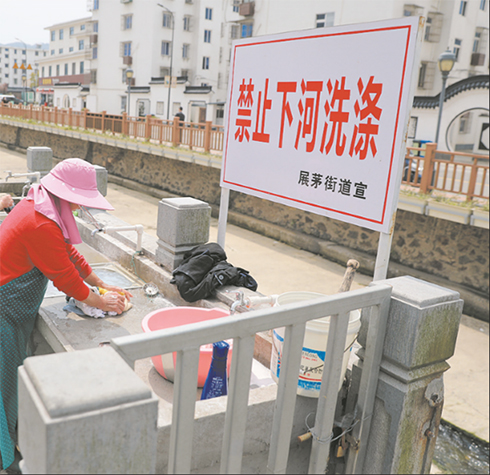 Zhoushan, Zhejiang province developed the infrastructure of sewage and tap water system ...: to prevent villagers from utilizing water of the river to wash clothes. The sign reads “The sign means: Please do not wash clothes in the river.” Cited from: China Environment News(2020), https://www.cenews.com.cn/news/tp/202004/t20200401_936064.html
Zhoushan, Zhejiang province developed the infrastructure of sewage and tap water system ...: to prevent villagers from utilizing water of the river to wash clothes. The sign reads “The sign means: Please do not wash clothes in the river.” Cited from: China Environment News(2020), https://www.cenews.com.cn/news/tp/202004/t20200401_936064.html
For his Internship with Horizon International, an NGO based at Yale University, Zakaria focused on WASH, seeking stories to film from trash polluting city waterways serving as drinking water for local communities to the struggles to find potable water in rural communities. It was this search which lead him to the Ivory Coast.
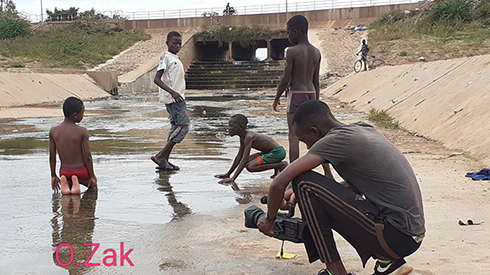 Zakaria Ouedraogo filming
Zakaria Ouedraogo filming
During World Water Week (25-30 August 2019) in Stockholm, The World Health Organization (WHO) and UN-Water called for an urgent increase in investment in strong drinking-water and sanitation systems. They cited a report by WHO published on behalf of UN-Water that “reveals that weak government systems and a lack of human resources and funds are jeopardizing the delivery of water and sanitation services in the world’s poorest countries – and undermining efforts to ensure health for all.” The report,” Weak systems and funding gaps jeopardize drinking-water and sanitation in the world’s poorest countries,” UN-Water Global Assessment and Analysis of Sanitation and Drinking-Water 2019 (known as the GLAAS report), surveyed 115 countries and territories, representing 4.5 billion people. It showed that, in an overwhelming majority of countries, the implementation of water, sanitation and hygiene policies and plans is constrained by inadequate human and financial resources.
The title, “Nzoue Fiyen,” means water not drinkable in a local language in the Ivory Coast, West Africa. The film was produced by Zakaria Ouedraogo of Burkina Faso for his Internship with Horizon International, an NGO based at Yale University.
- Anthony Solomon
- Birgitte Jyding Vennervald
- Charles H. King
- chemotherapy
- Daniel G. Colley
- David Mabey
- Emma Harding-Esch
- hygiene
- Janine Selendy
- Jens Aagaard-Hansen
- Joseph A. Cook
- Julianne A. Ivy
- Pascal Magnussen
- Paul Farmer
- provision of clean water
- Rockefeller Foundation
- sanitation
- Schistosomiasis control strategies
- Schistosomiasis transmission
- Silvio P. Mariotti
- snail control
- st. lucia
- WASH
- water
- World Heath Organization
- Global Health
- Public Health
- Sanitation
- Water
- Water and Sanitation
In 1965, the government of St. Lucia and the Rockefeller Foundation undertook what became a sixteen-year project to determine the optimal strategy for controlling locally-endemic schistosomiasis mansoni. Many of the world’s leading researchers on schistosomiasis control participated in the project, including experts in epidemiology, snail ecology, water and sanitation, social mobilization, clinical trials, immunology, and health economics. In the process, they brought infection levels in the new island nation to an impressive and steady low. Now fifty years later, the island has maintained its control of the parasite and may be on the cusp of achieving national Schistosoma mansoni elimination status.
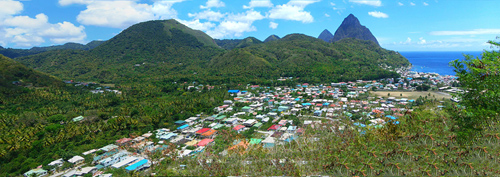 The town of Soufrière, St Lucia,: as seen from the road approaching it from the north, and in the background the twin peaks of Petit Piton and Gros Piton. By Gzdavidwong at Chinese Wikipedia - Transferred from zh.wikipedia to Commons., CC BY-SA 3.0, https://commons.wikimedia.org/w/index.php?curid=2326022
The town of Soufrière, St Lucia,: as seen from the road approaching it from the north, and in the background the twin peaks of Petit Piton and Gros Piton. By Gzdavidwong at Chinese Wikipedia - Transferred from zh.wikipedia to Commons., CC BY-SA 3.0, https://commons.wikimedia.org/w/index.php?curid=2326022
Faces of Courage: Intimate Portraits of Women on the Edge, a photo-essay by Mark Tuschman documents the lack of autonomy that women and girls face in the developing world and all the efforts designed to empower them. This article is from the section on "Healthcare Workers: Silent Heroes."
Healthcare Workers, Silent Heroes
“I am who I serve.”
Anonymous
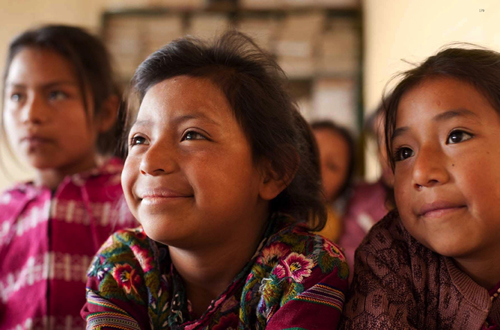 Girls in Guatemala
Girls in Guatemala
A team of scientists went to the Western Pacific Island chain of the Republic of Palau to unlock the mysteries of species that may contain a secret of adaptation for survival. The film “Coral: Glimmer of Hope” summarizes their journey and findings to date. The Republic of Palau is a country comprised of hundreds of islands.
Coral: Glimmer of Hope
A film by Gaelin Rosenwaks
- Agriculture
- books
- Climate change
- environmental engineering
- environmental health
- Epidemiology
- Global Health
- Harvard Medical School
- Harvard T. H. Chan School of Public Health
- medical anthropology
- medicine
- nutrition
- Paul Farmer
- population
- public health
- Air Pollution
- Biodiversity
- Desertification
- Global Climate Change
- Global Health
- Industry
- News and Special Reports
- Oceans, Coral Reefs
- Pollution
- Population
- Public Health
- Rivers
- Sanitation
- Toxic Chemicals
- Transportation
- Waste Management
- Water
- Water and Sanitation
The Authoritative Guide to Water and Sanitation Related Diseases, with Many Revised, Updated and New Chapters, Accompanies the First Edition
Augmenting authoritative interdisciplinary coverage in the first edition, this new edition of Water and Sanitation-Related Diseases and the Changing Environment expands upon the significance of the changing environment to disease vectors, food systems and nutrition, and population, and the importance of ecosystem health to human health. Many chapters stand as they are in first edition to which readers are referred, and which are not included in this volume.
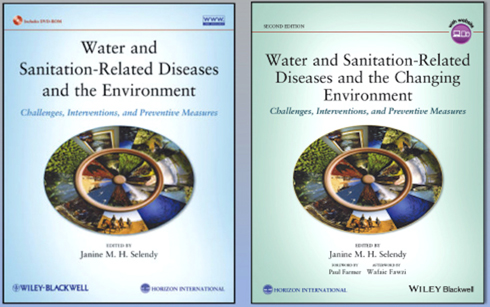 Two Volumes
Two Volumes
Written by 75 authorities from the fields of climate change, epidemiology, environmental health, environmental engineering, global health, medicine, medical anthropology, nutrition, population, and public health.
A new modeling approach using satellite data will likely to enhance our ability to develop cholera risk maps in several regions of the globe. The model (GCRM) is based on monthly air temperature, precipitation, availability of WASH (water, sanitation and hygiene) infrastructure, population density and severity of natural disaster.
Using Precipitation Data to Assess Risk of Cholera Outbreaks
A new NASA study finds that the recent drought that began in 1998 in the eastern Mediterranean Levant region, which comprises Cyprus, Israel, Jordan, Lebanon, Palestine, Syria, and Turkey, is likely the worst drought of the past nine centuries.
Scientists reconstructed the Mediterranean’s drought history by studying tree rings as part of an effort to understand the region’s climate and what shifts water to or from the area. Thin rings indicate dry years while thick rings show years when water was plentiful.
A new NASA study finds that the recent drought that began in 1998 in the eastern Mediterranean Levant region, which comprises Cyprus, Israel, Jordan, Lebanon, Palestine, Syria, and Turkey, is likely the worst drought of the past nine centuries.
Global sea level rise has been accelerating in recent decades, rather than increasing steadily, according to a new study based on 25 years of NASA and European satellite data.
Global sea level rise has been accelerating in recent decades, rather than increasing steadily, according to a new study based on 25 years of NASA and European satellite data.
Credits: NASA's Goddard Space Flight Center/Kathryn Mersmann
In June 2020, NASA provides an updated report on fresh water availability: "Of all of the water on Earth, 97% is saltwater, leaving a mere 3% as freshwater, approximately 1% of which is readily available for our use. The world’s population is becoming more and more reliant on this precious resource for power, irrigation, industrial practices, and daily consumption." The report is available at: https://earthdata.nasa.gov/learn/toolkits/freshwater-availability
In a first-of-its-kind study, scientists have combined an array of NASA satellite observations of Earth with data on human activities to map locations where freshwater is changing around the globe and to determine why.
The study, published Wednesday in the journal Nature, finds that Earth’s wet land areas are getting wetter and dry areas are getting drier due to a variety of factors, including human water management, climate change and natural cycles.
A team led by Matt Rodell of NASA’s Goddard Space Flight Center in Greenbelt, Maryland, used 14 years of observations from the U.S./German-led Gravity Recovery and Climate Experiment (GRACE) spacecraft mission to track global trends in freshwater in 34 regions around the world.
In a first-of-its-kind study, scientists have combined an array of NASA satellite observations of Earth with data on human activities to map locations where freshwater is changing around the globe and to determine why.
Meet Freddy, a fat little fly who loves toilet fondue! Find out what happens to him when the village where he lives is 'triggered' into cleaning up their act to become open defecation free (ODF).Meet Freddy the Fly: A New Video Promotes Open Defecation Free Living
WSSCC: Freddy the Fly
Meet Freddy the Fly, a video illustrating a community’s journey to open defecation free status – from the fly’s perspective!
“My health is in my hands”! School kids affirmed their resolve. The Beautiful Feet International (BFI) WinS project is making them catch on how to take responsibility for their own health and wellness in school and at home as a good way to securing their future despite the prevailing poor environmental learning conditions they are daily being subjected to due to annual flooding, environmental degradation and government neglect which has made WASH emergency higher in the area. All the schools in the WinS project are in Evbuotubu, a flood prone community in Egor Local Government Area of Edo State, Nigeria.
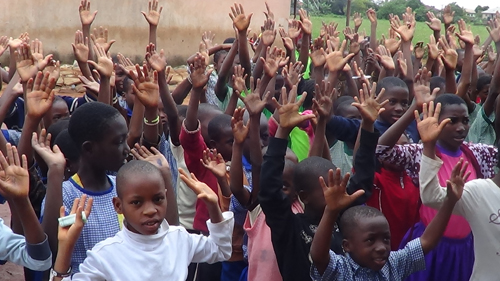 My health is in my hands!
My health is in my hands!
Search
Latest articles
Agriculture
- World Water Week: Healthy ecosystems essential to human health: from coronavirus to malnutrition Online session Wednesday 24 August 17:00-18:20
- World Water Week: Healthy ecosystems essential to human health: from coronavirus to malnutrition Online session Wednesday 24 August 17:00-18:20
Air Pollution
- "Water and Sanitation-Related Diseases and the Changing Environment: Challenges, Interventions, and Preventive Measures" Volume 2 Is Now Available
- Global Innovation Exchange Co-Created by Horizon International, USAID, Bill and Melinda Gates Foundation and Others
Biodiversity
- World Water Week: Healthy ecosystems essential to human health: from coronavirus to malnutrition Online session Wednesday 24 August 17:00-18:20
- Mangrove Action Project Collaborates to Restore and Preserve Mangrove Ecosystems
Desertification
- World Water Week: Healthy ecosystems essential to human health: from coronavirus to malnutrition Online session Wednesday 24 August 17:00-18:20
- UN Food Systems Summit Receives Over 1,200 Ideas to Help Meet Sustainable Development Goals
Endangered Species
- Mangrove Action Project Collaborates to Restore and Preserve Mangrove Ecosystems
- Coral Research in Palau offers a “Glimmer of Hope”
Energy
- Global Innovation Exchange Co-Created by Horizon International, USAID, Bill and Melinda Gates Foundation and Others
- Wildlife Preservation in Southeast Nova Scotia
Exhibits
- Global Innovation Exchange Co-Created by Horizon International, USAID, Bill and Melinda Gates Foundation and Others
- Coral Reefs
Forests
- NASA Satellites Reveal Major Shifts in Global Freshwater Updated June 2020
- Global Innovation Exchange Co-Created by Horizon International, USAID, Bill and Melinda Gates Foundation and Others
Global Climate Change
- World Water Week: Healthy ecosystems essential to human health: from coronavirus to malnutrition Online session Wednesday 24 August 17:00-18:20
- Mangrove Action Project Collaborates to Restore and Preserve Mangrove Ecosystems
Global Health
- World Water Week: Healthy ecosystems essential to human health: from coronavirus to malnutrition Online session Wednesday 24 August 17:00-18:20
- More than 400 schoolgirls, family and teachers rescued from Afghanistan by small coalition
Industry
- "Water and Sanitation-Related Diseases and the Changing Environment: Challenges, Interventions, and Preventive Measures" Volume 2 Is Now Available
- Global Innovation Exchange Co-Created by Horizon International, USAID, Bill and Melinda Gates Foundation and Others
Natural Disaster Relief
- STOP ATTACKS ON HEALTH CARE IN UKRAINE
- Global Innovation Exchange Co-Created by Horizon International, USAID, Bill and Melinda Gates Foundation and Others
News and Special Reports
- World Water Week: Healthy ecosystems essential to human health: from coronavirus to malnutrition Online session Wednesday 24 August 17:00-18:20
- STOP ATTACKS ON HEALTH CARE IN UKRAINE
Oceans, Coral Reefs
- World Water Week: Healthy ecosystems essential to human health: from coronavirus to malnutrition Online session Wednesday 24 August 17:00-18:20
- Mangrove Action Project Collaborates to Restore and Preserve Mangrove Ecosystems
Pollution
- Zakaria Ouedraogo of Burkina Faso Produces Film “Nzoue Fiyen: Water Not Drinkable”
- "Water and Sanitation-Related Diseases and the Changing Environment: Challenges, Interventions, and Preventive Measures" Volume 2 Is Now Available
Population
- "Water and Sanitation-Related Diseases and the Changing Environment: Challenges, Interventions, and Preventive Measures" Volume 2 Is Now Available
- "Water and Sanitation-Related Diseases and the Changing Environment: Challenges, Interventions, and Preventive Measures" Volume 2 Is Now Available
Public Health
- Honouring the visionary behind India’s sanitation revolution
- Honouring the visionary behind India’s sanitation revolution
Rivers
- World Water Week: Healthy ecosystems essential to human health: from coronavirus to malnutrition Online session Wednesday 24 August 17:00-18:20
- Mangrove Action Project Collaborates to Restore and Preserve Mangrove Ecosystems
Sanitation
- Honouring the visionary behind India’s sanitation revolution
- Honouring the visionary behind India’s sanitation revolution
Toxic Chemicals
- "Water and Sanitation-Related Diseases and the Changing Environment: Challenges, Interventions, and Preventive Measures" Volume 2 Is Now Available
- Actions to Prevent Polluted Drinking Water in the United States
Transportation
- "Water and Sanitation-Related Diseases and the Changing Environment: Challenges, Interventions, and Preventive Measures" Volume 2 Is Now Available
- Urbanization Provides Opportunities for Transition to a Green Economy, Says New Report
Waste Management
- Honouring the visionary behind India’s sanitation revolution
- Honouring the visionary behind India’s sanitation revolution
Water
- Honouring the visionary behind India’s sanitation revolution
- Honouring the visionary behind India’s sanitation revolution
Water and Sanitation
- Honouring the visionary behind India’s sanitation revolution
- Honouring the visionary behind India’s sanitation revolution

